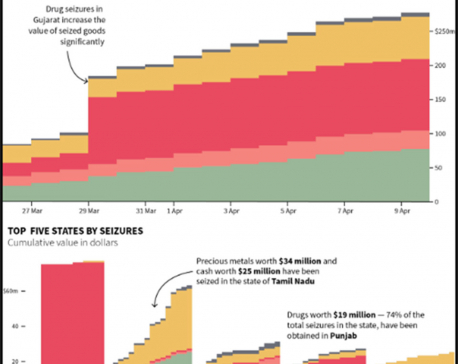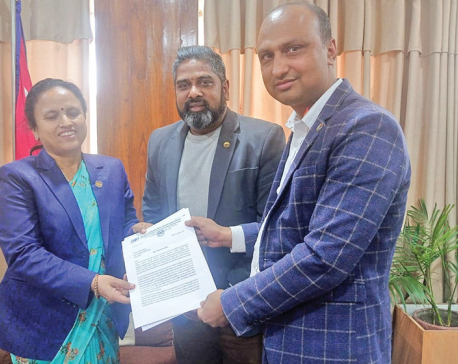
OR
How fast can Nepal go cashless?
Published On: March 12, 2020 10:54 AM NPT By: Republica | @RepublicaNepal

KATHMANDU, March 12: Gone are the days when people used to carry bags full of cash to settle large amount of transactions, as people are now picking up with cashless transaction modes, though at slower pace in contrast to escalating technologies.
Cashless payments are all payments made without the need of physical money. Use of bank-issued cards, internet banking, mobile wallet, digital payment apps, unified payments interface service, banks prepaid cards and mobile banking, among others, are some of the means to carry out the cashless transactions. The systems keep individuals out of risk of losing cash, torn of currency and other cash hitches along with providing security for both vendors and customers from possible theft and robberies. Apart from these, it also helps cut down the hassles of standing in a long queue for payments and reduces the costs of transactions.
“Digitization is a continuous process. Though the fully cashless society is far from reach, the process has already been started in Nepal,” said Ashoke SJB Rana, chief executive officer of Himalayan Bank. “The gradual evolution of cashless banking has emerged from cheques through internet banking, low-value mobile wallet, QR code and fintech.”
Although the security mechanism of digital transactions in Nepal is often put to question in many cases, both the people and business houses have been entrusting the payment modules that do not use physical cash. The system is slowly making up its space with the business fraternity thriving to introduce new technology in payment systems at the wake of changing lifestyle of the people. This has even forced the government to implement the system in order to reduce the hassle to provide prompt service to the people.
Currently, many people are now adopting the service of online payment system to clear the dues of utility services like electricity, water supply, telecommunications, cable operators and booking for the transports. Likewise, shoppers are finding it easy to clear bills via card or online payment services.
From petrol depots to butcher shops, a growing number of businesses have been opting for the use of QR code for cashless payments. Digitals wallets like eSewa, IMEPay, Khalti and PrabhuPay have proliferated particularly this year, making aggressive marketing pushes into retail. Similarly, numbers of banks have also developed digital wallets, alongside existing tech companies such as Janaki Technologies' Khalti and F1Soft's eSewa.
In addition to the private sector, the government agencies have also been facilitating the online systems to submit details to receive government services along with introducing the online payment system to clear bills for the public services.
The Inland Revenue Department (IRD), since mid February, has started providing a 10% VAT refund for digital transactions. Two years ago, the Nepal Rastra Bank enforced the rule to carry out all transaction of more than Rs 1 million mandatory through the account payee cheque. Last September, the central bank also launched Real Time Gross Settlement (RTGS) system, making it mandatory for the banks while carrying out transactions worth above Rs 2 million. The system is expected to ensure quick clearance and settlement of high-value cheques besides curbing possible transactions from money launderers and terrorists.
Despite the number of cashless apps available to users, most consumers still prefer cash, according to service providers and vendors. However, an increased number of smart phone users, mostly the youths, have slowly been picking up the use of the cashless services. According to Nepal Rastra Bank, the number of mobile banking users soared five-fold – from 1.75 million in 2016 to 8.34 million in 2019. It covers around 29% of the total population. Data also shows that more than 52% of internet users in Nepal avail mobile broadband services.
Analysts stressed on the need for extending the cashless system in rural areas in the future. “The system that has emerged mainly from urban area needs to trickle down to rural areas that are deprived of basis infrastructures,” said Rana.
You May Like This

India gold smuggling slowed by election seizures of cash, bullion
MUMBAI, April 15: India’s gold smugglers have slowed their operations over worries their shipments will be caught up in seizures... Read More...

CAN draws govt’s attention to digital payment
KATHMANDU, April 6: The Computer Association of Nepal (CAN) Federation has drawn the attention of various ministries and government agencies... Read More...

Suspicious transactions: Reporting entities more vigilant
KATHMANDU, April 19: The number of suspicious transaction reports (STRs) by various bank and financial institutions, insurance companies and securities... Read More...










Just In
- Heavy rainfall likely in Bagmati and Sudurpaschim provinces
- Bangladesh protest leaders taken from hospital by police
- Challenges Confronting the New Coalition
- NRB introduces cautiously flexible measures to address ongoing slowdown in various economic sectors
- Forced Covid-19 cremations: is it too late for redemption?
- NRB to provide collateral-free loans to foreign employment seekers
- NEB to publish Grade 12 results next week
- Body handover begins; Relatives remain dissatisfied with insurance, compensation amount







Leave A Comment